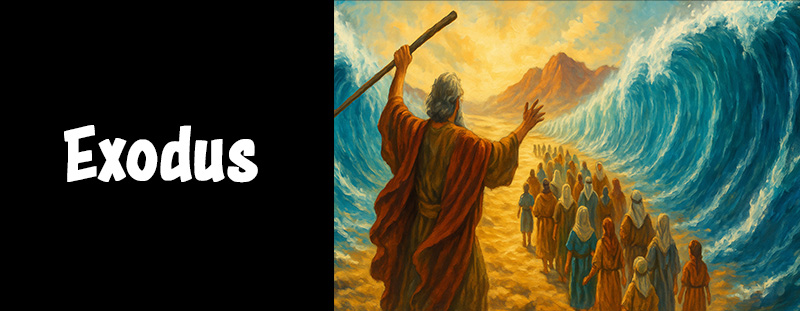👑 Clothed for Service: Holiness and Divine Appointment 👑
“And take thou unto thee Aaron thy brother, and his sons with him, from among the children of Israel, that he may minister unto me in the priest’s office.” – Exodus 28:1 (KJV)
Exodus 28 details God’s instructions for the priestly garments, worn by Aaron and his sons. These garments were not mere clothing—they were sacred symbols of holiness, authority, and mediation between God and His people. Every color, gem, and design element carried spiritual significance, teaching Israel about divine order, reverence, and the nature of service.
The chapter emphasizes that those chosen to serve in God’s presence must be set apart, adorned in holiness, and empowered by His Spirit. Through these instructions, God conveys the seriousness of ministry and the beauty of worship that is both orderly and Spirit-filled.
📜 Structure of Exodus Chapter 28
Verses 1–5: The Selection of Aaron and His Sons
God instructs Moses to take Aaron and his sons from among the Israelites. They were chosen to minister in the priestly office. The call to service was not for personal honor but for holy purpose—mediating God’s presence to the people. Their separation highlights that ministry requires dedication, obedience, and divine selection.
Verses 6–14: The Ephod
The ephod was a special vestment worn over the priest’s robe. Made of gold, blue, purple, and scarlet yarn with finely twined linen, it represented wealth, beauty, and divine glory. Two onyx stones engraved with the names of the twelve tribes of Israel were placed on the shoulders, signifying that the priest bore the people before God. The ephod symbolizes intercession, responsibility, and remembrance.
Verses 15–30: The Breastplate and Urim and Thummim
Attached to the ephod was the breastplate of judgment, square and set with twelve precious stones, each representing a tribe. The Urim and Thummim, kept within the breastplate, were used to discern God’s will. This sacred ensemble emphasizes that God calls His servants to mediate His guidance and justice with wisdom and holiness.
Verses 31–35: The Robe and Bells
The robe worn under the ephod was entirely blue, with pomegranates of blue, purple, and scarlet and golden bells around the hem. The sound of the bells marked God’s presence and reminded the priest that holiness must be constant, audible, and visible in service. The interplay of beauty and function illustrates that worship engages heart, mind, and senses.
Verses 36–43: The Turban and Anointing
The turban (or mitre) completed the high priest’s attire, with a gold plate inscribed: “Holiness to the Lord.” The anointing oil consecrated Aaron and his sons, setting them apart for God’s service. Their entire wardrobe was a visible declaration of sanctification, teaching that ministry is sacred, purposeful, and divinely authorized.
💡 Key Themes
✨ Holiness in Service
The priestly garments show that approaching God requires purity, preparation, and reverence. God’s servants must reflect His glory and bear His people with integrity.
✨ Mediation and Responsibility
Aaron and his sons symbolize intercession. Ministry is not about personal power but carrying the people before God, seeking His will, and upholding His covenant.
✨ Divine Beauty and Order
Every color, gem, and stitch communicates God’s beauty and order. Worship is both orderly and creative, combining artistry with obedience.
👤 Key People
- Aaron – The first high priest, chosen to mediate between God and Israel.
- Aaron’s Sons – Called to assist in priestly duties, set apart for service.
- Moses – Overseer and recipient of God’s precise instructions.
- The Israelites – Represented in the priestly garments, showing their collective dependence on God’s guidance.
🔥 Why This Chapter Matters
Exodus 28 teaches that ministry requires holiness, dedication, and divine calling. Every element of the priestly garments points to God’s presence, guidance, and glory. For believers today, it reminds us that serving God is not casual—it is sacred, purposeful, and transformative. Through these garments, Israel glimpsed a higher reality: Christ, the ultimate High Priest, who intercedes for humanity and bears us into God’s presence with perfect holiness.
💭 Let’s Reflect
- How do the priestly garments inspire your understanding of holiness in your own life?
- In what ways can you “bear the people before God” in your daily actions or ministry?
- How does recognizing God’s beauty and order in worship deepen your spiritual devotion?
❓Ready to Go Deeper?
👉 Click here to begin reading Exodus Chapter 29
Or, if you’d like to jump to a specific chapter in Exodus, simply click the chapter number below:
1 | 2 | 3 | 4 | 5 | 6 | 7 | 8 | 9 | 10 | 11 | 12 | 13 | 14 | 15 | 16 | 17 | 18 | 19 | 20 | 21 | 22 | 23 | 24 | 25 | 26 | 27 | 28 | 29 | 30 | 31 | 32 | 33 | 34 | 35 | 36 | 37 | 38 | 39 | 40

